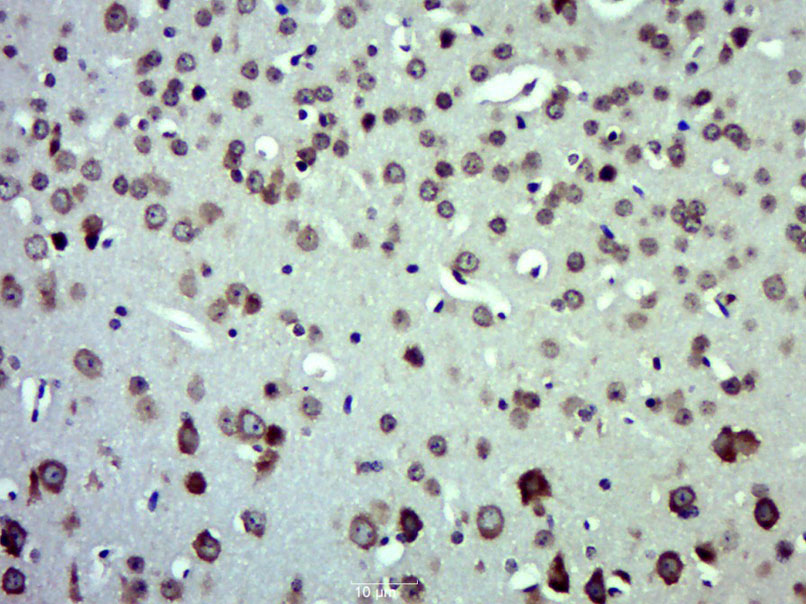
Rabbit Anti-CXCL11 antibody
b R1; b-R1; Beta-R1; betaR1; C-X-C motif chemokine 11; Chemokine (C-X-C motif) ligand 11; Chemokine C-X-C motif ligand 11; CXC11; CXCL11; CXL11_MOUSE; H174; I TAC; I-TAC; Interferon gamma inducible protein 9; Interferon gamma-inducible protein 9; Interfer
View History [Clear]
Details
Product Name CXCL11 Chinese Name Interferon诱导T细胞Chemokine抗体 Alias b R1; b-R1; Beta-R1; betaR1; C-X-C motif chemokine 11; Chemokine (C-X-C motif) ligand 11; Chemokine C-X-C motif ligand 11; CXC11; CXCL11; CXL11_MOUSE; H174; I TAC; I-TAC; Interferon gamma inducible protein 9; Interferon gamma-inducible protein 9; Interferon inducible T cell alpha chemoattractant; Interferon-inducible T-cell a chemoattractant I-TAC; Interferon-inducible T-cell alpha chemoattractant; IP 9; IP-9; IP9; ITAC; MGC102770; SCYB11; SCYB9B; small inducible cytokine B11; small inducible cytokine subfamily B (Cys-X-Cys) member 11; small inducible cytokine subfamily B (Cys-X-Cys) member 9B; Small inducible cytokine subfamily B, member 11; Small inducible cytokine subfamily B, member 9B; Small-inducible cytokine B11. literatures Research Area immunology Neurobiology Chemokine t-lymphocyte Immunogen Species Rabbit Clonality Polyclonal React Species Mouse, (predicted: Rat, ) Applications ELISA=1:5000-10000 IHC-P=1:100-500 IHC-F=1:100-500 IF=1:100-500 (Paraffin sections need antigen repair)
not yet tested in other applications.
optimal dilutions/concentrations should be determined by the end user.Theoretical molecular weight 9kDa Cellular localization Secretory protein Form Liquid Concentration 1mg/ml immunogen KLH conjugated synthetic peptide derived from mouse CXCL11: 22-100/100 Lsotype IgG Purification affinity purified by Protein A Buffer Solution 0.01M TBS(pH7.4) with 1% BSA, 0.03% Proclin300 and 50% Glycerol. Storage Shipped at 4℃. Store at -20 °C for one year. Avoid repeated freeze/thaw cycles. Attention This product as supplied is intended for research use only, not for use in human, therapeutic or diagnostic applications. PubMed PubMed Product Detail Chemokines are a group of small (approximately 8 to 14 kD), mostly basic, structurally related molecules that regulate cell trafficking of various types of leukocytes through interactions with a subset of 7-transmembrane, G protein-coupled receptors. Chemokines also play fundamental roles in the development, homeostasis, and function of the immune system, and they have effects on cells of the central nervous system as well as on endothelial cells involved in angiogenesis or angiostasis. Chemokines are divided into 2 major subfamilies, CXC and CC. This gene is a CXC member of the chemokine superfamily. Its encoded protein induces a chemotactic response in activated T-cells and is the dominant ligand for CXC receptor-3. The gene encoding this protein contains 4 exons and at least three polyadenylation signals which might reflect cell-specific regulation of expression. IFN-gamma is a potent inducer of transcription of this gene. [provided by RefSeq].
Function:
Chemotactic for interleukin-activated T-cells but not unstimulated T-cells, neutrophils or monocytes. Induces calcium release in activated T-cells. Binds to CXCR3. May play an important role in CNS diseases which involve T-cell recruitment. May play a role in skin immune responses (By similarity).
Subcellular Location:
Secreted.
Similarity:
Belongs to the intercrine alpha (chemokine CxC) family.
SWISS:
Q9JHH5
Gene ID:
56066
Database links:
Entrez Gene: 6373 Human
Entrez Gene: 56066 Mouse
Omim: 604852 Human
SwissProt: O14625 Human
SwissProt: Q9JHH5 Mouse
Unigene: 632592 Human
Product Picture
References (0)
No References
Bought notes(bought amounts latest0)
No one bought this product
User Comment(Total0User Comment Num)
- No comment



 +86 571 56623320
+86 571 56623320
 +86 18668110335
+86 18668110335

